Monday, June 13, 2016 | 2 a.m.
What’s the difference between a dancer and a showgirl?
Former “Jubilee” company manager Diane Palm said lines have blurred over time, but dancers usually had more involved choreography and were completely covered, while showgirls were topless and had more flamboyant costumes and less dynamic movement. She said audiences could be forgiven for not making the distinction. “It’s because of the fantastic, elaborate, wonderful costumes that we all wore,” said Palm, who was a dancer for years.
While a dancer might have worn a 3-foot-tall headdress, for example, a showgirl could be crowned with an even taller piece that “cascaded” around her body. “You could have your arms out to the side and you could barely touch the edges of the headdress,” Palm said.
The Costume
Philipo said even what would be considered a simple showgirl costume requires a “hell of a lot of work.” First, a design must be carefully mapped out and planned for precise execution. And often, an entire team is required to do the patterning, fabric cutting, feather work and jeweling. (Philipo, however, does it all.)
Karen Burns, a former chorus dancer in the Reno production “Hello Hollywood Hello” who owns more than 1,200 pieces of that show's wardrobe, agreed that elaborate costume work is key to defining a showgirl show. Topless isn’t a firm requirement in her eyes, but she acknowledged it’s definitely part of showgirl culture.
The Production
Las Vegas Showgirl Museum founder Grant Philipo lists two ingredients for a classic showgirl production, based on his view of the Las Vegas entertainment tradition.
1. “It really has to be topless to be considered a true showgirl show.”
2. “It’s the money that goes into the actual wardrobe that is worn, so even though she’s topless, she still has a ridiculously expensive amount of wardrobe on.”
The Topless Debate
Former dancer Karen Burns and collector Grant Philipo stressed that the topless aspect didn’t make showgirl productions prurient, and that there was a lot more going on than, as Burns put it, “just gorgeous topless showgirls standing there.” “It’s like when you go in a museum and you see a nude statue of a man or a woman. You don’t think vulgar thoughts, you think, ‘Oh my god, that’s so incredible,’ ” Philipo asserted. “It’s the same thing when you go and see a showgirl or showboy; it should give you the same kind of feeling. The only thing is it’s even better because it’s actually breathing. It’s actually alive.”
The flamboyant guests in Grant Philipo’s living room are dressed in scanty yet elegant costumes dripping with crystals, feathers and glitz. They are six mannequins, carefully arranged in a tableau, standing with hands raised or hanging by their sides. Together, their elaborate headdresses and finely crafted body pieces form a cornucopia of retro glamour.
These aren’t knockoffs from a pop-up Halloween store. They’re the real deal, from authentic shows on the Las Vegas Strip. And they’re in good company: Nearly every corner in the house celebrates some physical fragment of past productions of stage and screen.
On one long table lies a silver mannequin draped in a daring gown of orange and white fur, designed by Philipo. It leaves much of the mannequin’s legs and upper chest bare, showing off an ornate necklace created for Carol Channing to wear in the film “Thoroughly Modern Millie.”
Another room brims with oversized puppet faces from “Errol Manoff’s Fantasy Factory.” Their features are eerily realistic, accentuated to an almost clownish degree by bright sequins and thickly painted makeup.
Among the living room’s decadent sextet, a gold-colored male figure wears a massive 65-pound “backpack” festooned with more than 5,000 individually wired feathers, one of Philipo’s eye-popping creations for a show he once produced at the Dunes.
His collection of more than 20,000 artifacts is so large that much of it is still in storage. The most significant elements, arguably, are the costumes from bygone Las Vegas shows such as “Jubilee,” “Hallelujah Hollywood” and “Lido de Paris.” The collection is essentially a love letter to the iconic Vegas showgirl, and the home in Paradise Palms — fittingly, a historic tract of mid-century modernism built during the Rat Pack era — is its church, under the banner of Grant Philipo’s Las Vegas Showgirl Museum.
For years Philipo led guided tours, offering an up-close look at the trappings of the sort of vintage production no longer found on the Strip. Women dressed in showgirl regalia still pose for tips on Las Vegas Boulevard, but the real thing has all but disappeared from the city’s legendary showrooms.
That’s partly what fuels Philipo’s mission to preserve retired entertainment treasures from Vegas and beyond, and to put them in a commercial space for public exploration. But this year, after an intense exchange with Clark County officials, the road to getting there became bumpier than a rhinestone-studded bra.
• • •
The seed of the museum was a swimsuit Philipo’s great grandmother wore a century ago. She was considered “very scandalous” in 1915, when she donned a sleeveless black-and-white suit with little material covering her legs. She passed it down to Philipo decades ago, and it became the foundation of his collection.
His interest in the stories reflected in clothing grew when he traveled from his native Iowa to Las Vegas in 1976 for a monthlong stay at Caesars Palace. During the extended vacation, he had an insatiable appetite for seeing glamorous shows on the Strip — and a keen memory for their fabulous costumes.
When he moved to San Diego for a job that year, he started recognizing outfits from Las Vegas shows in antique stores and yard sales. He had to have them. They were historical. And gorgeous.
“I would see these things and think, ‘Oh my God — that was in Frederic Apcar’s show!’" Philipo said. "I don’t know why I was buying them, but I knew they were important.”
A modeling job later took him to Los Angeles, where he also landed work doing rhinestoning for a costume house. He says that over nearly a decade, his work in LA put him on all sides of the stage, from designing costumes to producing and starring in shows. As his costume collection grew, Philipo says he began receiving calls from people looking to off-load show remnants.
“I had no clue what I was going to do with them. I certainly didn’t think I would have a museum,” he said. "Designers would call me up and say, ‘You know, I’ve got these things,’ or, ‘I’ve got sketches … if you want them, you can have them, because I know you’ll protect them.’”
With his stockpile of costumes, Philipo relocated to Las Vegas permanently in 1990, seeing fate in the echoes of his work in so many Strip staples: feathers, jewels, topless dance numbers. It’s where he met someone else who cared deeply about show business, someone who would prove instrumental in his quest to protect these wisps of entertainment history.
Mary Dee Mantle wasn’t a dancer. She was a flight attendant who started selling exotic garments gathered on her journeys abroad. That enterprise led to a chance encounter with Philipo, and the two became close.
Mantle — whose brother-in-law was New York Yankees legend Mickey Mantle — agreed to be an executive producer on Philipo’s Dunes extravaganza “90 Degrees & Rising.” She went on to help him produce other shows and secure more costumes. And in 2002, she bought a home in Paradise Palms to provide one roof under which Philipo could house the collection, design and build costumes, work on producing shows and sleep.
“When I was 60, I wore my first Halloween costume that (Philipo) made me, and I asked my husband, ‘What do you think of this?’ He said, ‘Oh, that’s nice.’ I said, ‘That’s not nice — It’s fabulous!’” recalled 81-year old Mantle. “And I was bit. I loved being around the showkids. I just love everything about it.”
In 2010, they opened the home for free tours. Philipo is the CEO and head curator, Mantle is the president and financial backer, and magician Dallas Fueston — “the brains,” per Philipo — is vice president of the unconventional outfit. They insist that from the beginning, they never intended to operate a commercial business, and never charged admission.
They didn’t pay for advertising, either, so awareness of the museum came largely through word of mouth and its Facebook page and website, along with a 2013 appearance on the Discovery Channel reality show “Extreme Collectors.”
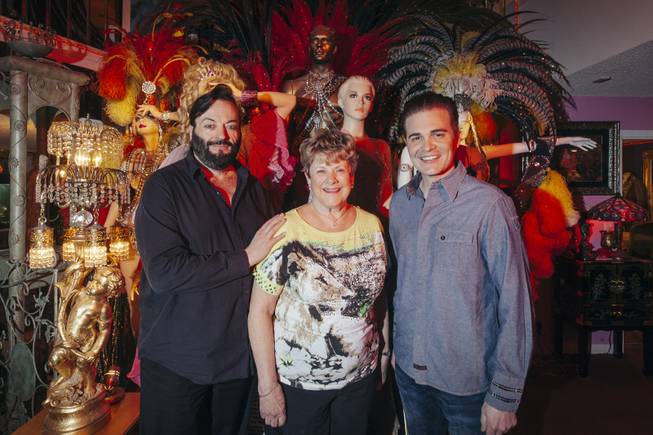
CEO and Head Curator Grant Philipo, President Mary Dee Mantle and Vice President Dallas Fueston of the Las Vegas Showgirl Museum.
Still, that didn’t add up to crowds beyond the occasional group of UNLV students, the museum crew says. Longtime neighbor Brigid Kelly, a former dancer, said she wouldn’t have known about it had she not gotten a peek inside while driving past.
“I could see the headdresses going up the stairs, and I thought, ‘Oh my gosh, it’s show people! Show people, I know it,’” Kelly said.
At least one anonymous neighbor didn’t share her excitement. Mantle found a notice on the gate in late 2015, stating that a complaint had been filed with Clark County.
• • •
“Do you have any kind of sex parties there?” Clark County Commissioner Chris Giunchigliani asked, claiming she’d received a report to that effect.
The Showgirl Museum’s founder was stunned.
It was one of many tense moments at the February 3 hearing before the county Zoning Commission to determine if the museum could continue operating out of the house in Paradise Palms. “We’re very social people; we don’t have sex parties,” Philipo said, adding that the house did host weekly Uno parties and occasional celebrations for special events such as the Academy Awards and Halloween.
Following the county’s initial notice, Philipo and his partners had learned they needed a special-use permit to keep running tours, a process that started with an appearance before their local town board and then the county Planning Commission. Both approved the museum's application.
But Giunchigliani disagreed with those decisions and appealed the matter to the February hearing, where Philipo and Fueston presented a video showcasing the collection. They spoke about the purpose of the museum, the support they’d received from neighbors and their intent to move to a permanent site.
More than a dozen people, including retired performers, later voiced their support, citing the importance of preserving history in a city known for imploding its past.
“My dream was to come here to become a showgirl. And I did,” former “Jubilee” and “Les Folies Bergere” performer Pamela Schumacher said, fighting back tears. “I want my children to be able to see part of what I did and what I wore and how important it was, and that it’s not ... the stigma of what a lot of people think that being a showgirl is.”
Giunchigliani had previously questioned whether the museum was charging for tours, and asked if anyone other than Philipo and a roommate was renting the home (he said no to both). The commissioner also said she’d been uninvited from a scheduled visit to the museum, a recollection organizers disputed.
“Honest to God, it wouldn’t have been any worse if we had killed somebody and we were on trial,” Mantle said of the experience. “It was terrible.”
Even if the county allowed for the special-use permit, Giunchigliani said, the house would need to be brought up to code. That would likely cost thousands of dollars to rectify issues such as accessibility under the Americans with Disabilities Act. Better, she argued, to spend the money on a permanent facility.
Commissioners unanimously decided they couldn’t allow the home tours to continue — with or without admission. For now, Philipo can still show the collection to neighbors or others who happen to come over, but the commission’s vote means he can’t solicit or provide public tours.
“They have to think smart about what they want to do,” Giunchigliani told The Sunday. “I felt their emotion and tie to what they’ve collected — that’s wonderful and I commend them for it. So, figure out a way to properly share it where you don’t get in trouble. There’s a more appropriate place.”
• • •
And there's definitely an audience. With the February closure of “Jubilee” at Bally’s, after a 34-year run, the showgirl effectively stepped out of the Strip’s headlining spotlight. It’s a turning point that has been widely mourned.
The elaborate, often topless showgirl show that “Jubilee” represented began slipping from the Strip’s landscape years ago, giving way to Cirque du Soleil’s dominance as well as big-name residencies and festivals. Yet the showgirl remains a symbol of Las Vegas, as much as the Rat Pack or Elvis. Maybe more so.
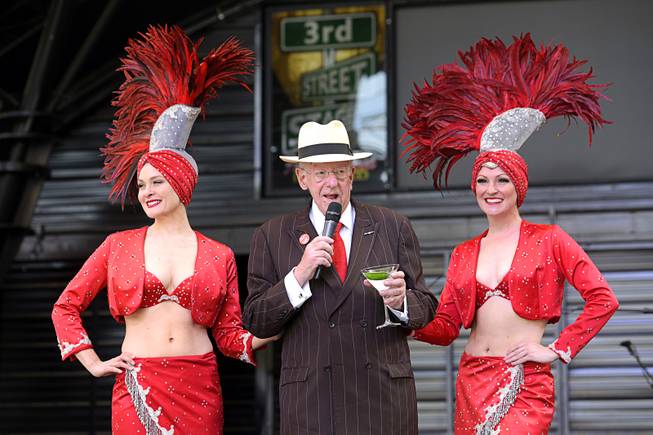
Showgirls Tara Taylor, left, and Jen Vossmer join Showgirls Tara Taylor, left, and Jen Vossmer help LVCVA Host Committee Chairman Oscar B. Goodman greet tourists during a flash mob event Wednesday, May 4, 2016, at the Fremont St. Experience to promote National Travel and Tourism Week.
Just ask former Mayor Oscar Goodman, an official ambassador for the city through the Las Vegas Convention and Visitors Authority.
“As far as the Convention Authority is concerned, myself with a martini in hand and showgirls at arm is the brand. And it represents everything that Las Vegas stands for: the glitz, the glamour, the iconic nature, the individualistic way that we’ve always done things,” he said. “The showgirls who accompany me really are the last vestige of a day that appears to have gone by, and that’s a shame, because it was an exciting time in Las Vegas where they represented all of that energy.”
Other cities may have had entertainers similar to showgirls, like the Rockettes in New York. “Minor league,” Goodman counters. He said Las Vegas was the major league for “these beautiful, statuesque young ladies who just exuded class.”
They were part of Vegas’ version of the production show, said Su Kim Chung, head of public services within UNLV’s Special Collections, which has archived numerous showgirl-related documents. “It’s really its own genre, the Las Vegas production show, and it has all kinds of special things that distinguish it, that make it different from a New York stage show or theater or ballet,” Chung said. “Maybe if people would appreciate it for its own special characteristics, they would realize that it really is worthy of study.”
Chung mentioned a signature moment in “Jubilee,” the grandiosity of its reenactment of the sinking Titanic.
Diane Palm understands the power of that spectacle well. The former “Jubilee” company manager recently completed a master’s in theater at UNLV, writing her thesis on Las Vegas production shows. She used to hear audience members talking about the grand flourishes after performances.
“People would say, ‘I had no idea it was so big;’ ‘I had no idea it was so fabulous;’ ‘I had no idea it was so great.’ … Without seeing it, you really don’t appreciate what a wonderful, theatrical type of entertainment it is,” Palm said.
But Las Vegas did not invent the showgirl.
Sultry productions at the famed Folies Bergère in Paris formed the inspiration of Florenz Ziegfeld’s “Ziegfeld Follies” in New York in the early 20th century. Ziegfeld became known for his “Ziegfeld girls,” chorus girls who predated the rise of the Las Vegas showgirl. They were attractive, stylish women dressed sexy and showy, but not nearly as over-the-top as the Vegas performers who followed.
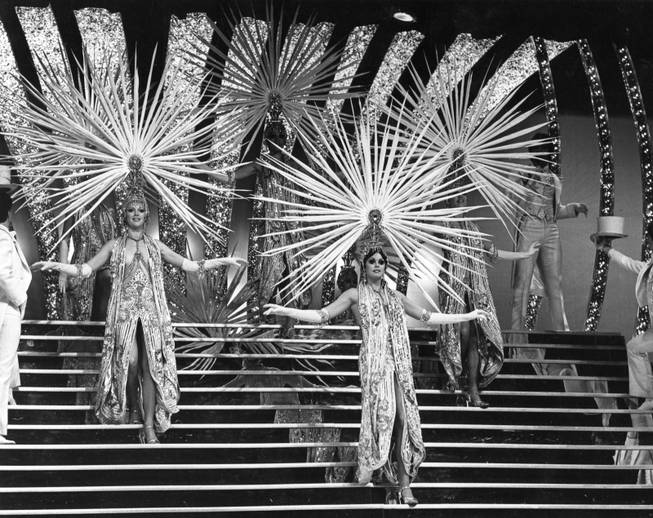
"Minksy's Follies of 1962" was lauded as “the show that made America blush” on the marquee of the New Frontier Hotel. The topless show was brought to Las Vegas in 1955 after it was forced out of New York for being too risqué.
The rise of showgirls in Las Vegas began around the 1950s as casinos competed for gamblers, partly by staging increasingly colorful productions. Imported directly from Paris, “Les Folies Bergere” ran for nearly a half-century at the Tropicana.
“You’re looking at a history of the female body. That’s why it has cultural importance, and why we need to pay attention to it,” Ohio State University professor Linda Mizejewski said of the showgirl’s evolution. “‘Jubilee’ closing really says something about where we’ve moved, culturally, from our ideas about the female body and female bodies on display.”
Mizejewski, who wrote “Ziegfeld Girl: Image and Icon in Culture and Cinema,” said showgirls in the United States arose as part of a broader “display culture” that could also be seen in the proliferation of storefront display windows and even beauty pageants. All of those were “displaying goods that are valuable,” she said.
Today’s audiences are accustomed to seeing the female body displayed on the Internet, in music videos and mass advertising. That has arguably contributed to the demise of big production shows featuring women in skimpy costumes beneath bedazzled headdresses. “It’s everywhere,” Mizejewski said of the female shape. “The idea of simply going somewhere to look at a body on display — maybe that’s not something we want to pay for anymore.”
Karen Burns, a Reno resident and former dancer who collected costumes from Donn Arden’s “Hello Hollywood Hello,” said it is the hotels that no longer want to pay. In the Strip’s increasingly competitive entertainment landscape, she thinks resort bosses prefer to buffer themselves from financial risk, hosting independently produced shows rather than fronting hugely expensive productions on their own.
• • •
Like other Vegas touchstones, mobsters and neon among them, showgirls are now the stuff of nostalgia — but lacking the level of critical attention afforded by the Mob Museum and Neon Museum.
Yet UNLV has collected its showgirl documents, and the Nevada State Museum has a “Showgirl Wall” featuring a rotating display of some dozen or more costumes. Last year, the state museum acquired costumes spanning the entire run of “Les Folies Bergere,” as well as a series of sketches and notations that Bob Mackie and Pete Menefee made for “Jubilee.”
Karan Feder, Nevada State Museum’s guest curator of costume and textiles, said many historic garments from Las Vegas shows have been destroyed. Imports from France often had bonds that came due, and the productions had to pay up or destroy the costumes. “Shows would take all the costumes out behind the casinos in the desert and light a bonfire,” Feder said. “Except for those few pieces that were squirreled away before they were lit on fire … it’s gone. It’s just absolutely gone.” She added that with the closure of “Jubilee,” we’re on the back end of an era ripe for examination.
“There really has been a beginning and end to it,” she said.
Feder was hired to help appraise Philipo’s tribute to that era when the museum appeared on the Discovery Channel. She valued a single silver gown once owned by Dionne Warwick at $5,000 to $10,000. A group of crystal accessories — Philipo had numerous others — appraised for $10,000.
Andrew Zegers, the host of “Extreme Collectors,” told Philipo that the collection was worth $15 million. Philipo had said his costumes required an investment of $2 million to $3 million over more than 35 years.
While the state museum also preserves costumes from Strip shows, Feder says Philipo’s effort is important in part because he has collected so much more. Beyond showgirl garb, he has Hollywood memorabilia ranging from a pair of ghoulish set pieces from the film “The Matrix Reloaded” to the entire set of costumes from Broadway show “Your Arms Are Too Short to Box with God.” He has myriad Parisian jewels, which Feder describes as “cool and wonderful.”
She mused that Philipo’s collection might get around some of the limitations imposed by the traditional museum industry. “I don’t know that the state museum, for instance, would be able to have a showcase. It’s really an entirely different venture,” she said. “I think the public would love seeing Grant’s collection. I hope that comes to pass.”
• • •
A few months after facing off with the Clark County Commission, Philipo was feeling better about the outlook for the Showgirl Museum. He said “lots of people” had made donations to help it find a permanent home.
“Of course, not being able to give tours is a constant battle, because people are contacting us every day and they just don’t understand that we don’t have the ability to let them come here,” he said. “It’s very disheartening to have to tell people no all the time. But it is what it is.”
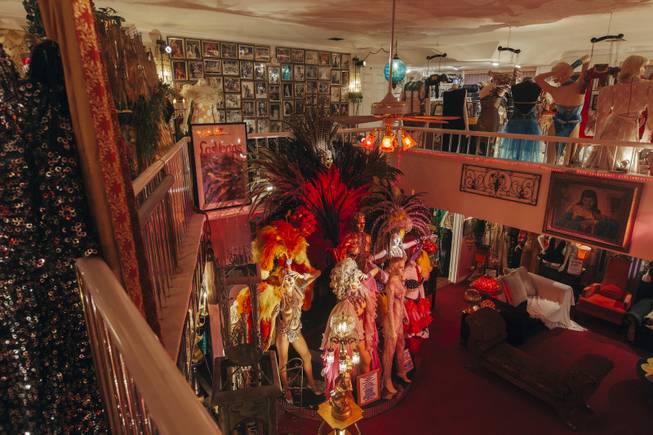
The Las Vegas Showgirl Museum on Feb. 12, 2016.
What’s more, Philipo said he recently received positive signals from Sen. Harry Reid, who gave the museum a commendation in December. Philipo was optimistic that the retiring senator might support the next phase in some capacity.
He seemed even more hopeful about assistance from city officials, including Mayor Carolyn Goodman. According to Philipo, Goodman has been helpful as backers consider moving the museum into a city-owned building. Philipo wouldn’t name a specific location but said if it panned out, the move would require approval from the Las Vegas City Council.
If that comes to pass, Philipo envisions the facility not only as a costume sanctuary, but also a space to provide classes on all aspects of show business, from singing, dancing and acting to costume design, construction and preservation, as well as set work. And there would be a modest showroom, where visitors could see showgirls perform in full splendor.
“Once we sign that dotted line, we will be opening our doors to students … (and) to interns, so that people will actually be able to work under me,” Philipo said. “It’s one thing to go to a college and try and learn all these different things. It’s another to actually work with someone who knows how to historically reclaim a costume and make it beautiful and new again.”
In addition, the museum’s partners are eyeing showrooms on the Strip and downtown, potentially to host a topless show Philipo sees bringing the true showgirl production back to Las Vegas. If that happens, it will only enhance their efforts to preserve an essential piece of the Vegas identity — no matter what else comes and goes from the hot stage lights.
Other ways to get your showgirl fix
While the strictest definition of the icon might be minus that rhinestone-studded top, the image of the beautiful, leggy performer decked in jewels and feathers is alive in Las Vegas, even if the Strip no longer has a production devoted exclusively to her.
• Oscar Goodman
Costumed showgirls accompany Las Vegas’ former mayor/official ambassador when he makes appearances for the Convention and Visitors Authority. He said many of them were once performers in “those wonderful line shows, the extravaganzas.”
“When I’m with the showgirls and I’ve got my drink in hand, the crowd actually goes wild. It’s like a rock star coming in,” Goodman said. “And it’s certainly not because of me. It’s the whole package: the package of the showgirls, the package of the booze, the package of the excitement, the package of the music. It just turns people on, and that’s what they expect should happen to them when they come to Las Vegas.”
• "Vegas! The Show": 3663 Las Vegas Blvd. South, Suite 454, vegastheshow.com
Distinguishing itself as “one of the only shows still featuring the iconic Las Vegas showgirls,” this buffet of Las Vegas entertainment includes a sumptuous showgirl number with a grand staircase and a troupe of dancers backing up Lady Luck.
• "Showgirl Follies"
Former dancer Mistinguett produces the annual two-night performance by former Strip dancers inside local retirement communities. It requires extensive rehearsal, and until Mistinguett can expand its reach, she’s focused on her mission of “keeping the showgirl alive” through community showcases.
• Williams Costume Co.: 1226 S. Third St., Las Vegas
For decades, Nancy Williams Baker has run her classic costume shop on 3rd Street near Charleston Boulevard in downtown Las Vegas. It’s filled with materials made for showgirl costuming — including more than $200,000 in rhinestones and beads alone. And Williams Baker’s shop has made about 15 full showgirl costumes, which customers can rent with various embellishments for $75 to $150 per day.
While not technically a showgirl, Williams Baker first came to Las Vegas in 1948 to dance at the El Rancho. Showgirls were not even around then, but she thinks they’ve become a representation of the city. “When people are talking about Las Vegas, they really identify with the showgirl,” she said.
• UNLV: Check it out online.
The university library’s Special Collections has archived numerous showgirl-related materials of the two-dimensional variety: documents, drawings, “anything that’s flat,” said Su Kim Chung, head of Special Collections public services. She said that the university did not have one overarching showgirl collection, but rather “a number of collections that have materials featuring showgirls,” including photos and programs. UNLV also has the personal papers of certain show producers and directors, as well as oral histories from showgirls.
• “Les Folies Bergere” exhibit: The Las Vegas Convention and Visitors Authority and its Las Vegas News Bureau, in partnership with the Nevada State Museum, debuted an exhibit June 11 titled “Les Folies Bergere: Entertaining Las Vegas, One Rhinestone at a Time.” It’s open at both the state museum and the Las Vegas Convention Center, and it’s meant to explore the “beauty, artistry and extravagance” of the historic Tropicana show.
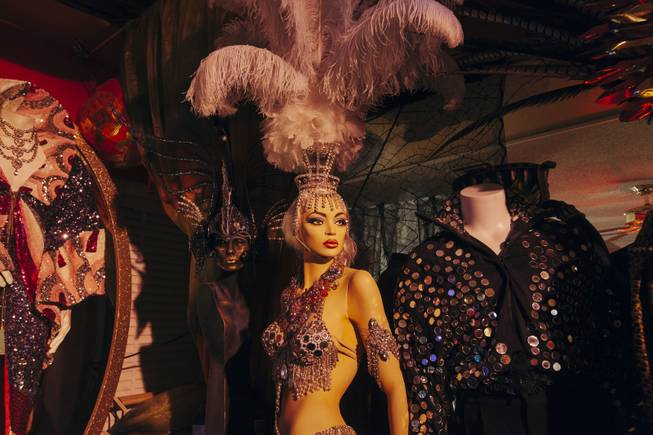
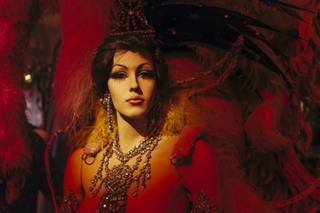

Join the Discussion:
Check this out for a full explanation of our conversion to the LiveFyre commenting system and instructions on how to sign up for an account.
Full comments policy